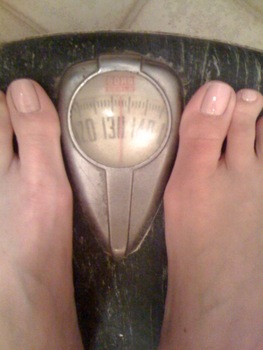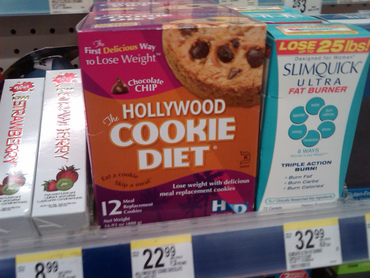 So back in my "Nutrition 101" days of my Naturopathic medical education, I learned the commonly taught old school nutrition idea of: "weight loss = more calories burnt than consumed" So that's it, huh? Eat less calories, burn more calories and weight loss will be a sure thing? Well, most of us know it's just not that easy. In fact, many find that they gain weight during and after dieting, even if they increase their activity level. So what's going on?! The fact of the matter is, only 1 in 6 dieters keeping the weight off (after a year). So why can't we all just follow that easy formula and lose those extra pounds?! ...because it just isn't so simple. We are a little more complex than calorie consuming and burning machines (but you probably knew that already). An article published last week in the Journal of the American Medical Association provides a little insight into some of those dieting and weight loss complexities. The publishing authors looked at overweight research participant using three different diet and weight loss programs and measured their success. The three diets were low-fat, low glycemic and low carbohydrate (high protein). Under carefully monitored in-patient hospital settings, the low glycemic dieters burned an average of 200 calories per day more than the low fat. The low carbohydrate dieters lost 300 calories more per day than the low fat dieters but saw an increase in blood levels of inflammatory markers (cortisol and CRP). So what does this all mean?! Just follow the diet where people burned the most calories while being constantly monitored in the hospital? Well, that doesn't sound like a very enjoyable diet program to me. If you're considering a weight loss-focused diet and exercise program, think about getting an expert involved to guide your path to success. If you haven't heard by now, my past 'slim down & happy up' program sessions have provided women (& men) with guided, individualized meal planning, diet guidelines and exercise recommendations. Combined with unique natural formulas that I craft specifically to each participant, this really is my all-in-one tool to address weight loss and stress reduction for long-term success. Registration for our next session opens Monday, August 19th, full details here. Join us for 3 months, and just see what a profound impact you and I can have on your health and quality of life!
0 Comments
Ninety percent (90%!) of cancers have preventable causes. Here's a quick "What are my chances of getting cancer" quiz. Count up your points for these health factors. Do you: Exercise? Yes= 0 Sometimes=1 Never=2 Smoke? No=0 Used to=1 Yes=2 Drink alcohol? No=0 More than 2 a day=2 Get checked for STIs? Yes I have=0 No or "What is that?" =1 Eat fast food? No=0 Occasionally=1 Daily=2 Have exposure to any of these known carcinogens (means cancer-causers). One point for each: radiation exposure (occupational or many, many X-rays), polluted water, chemical or industrial toxin exposure (such as from your occupation or living nearby a chemical plant) and a history of bad (blistering) sunburns. Now, if you didn't notice the pattern above, this is not the SATs. More points is not better- it's worse off for your cancer risk. And since 95-98% of all cancers are not genetic (inherited and perhaps inevitable), then that means there's ample time and resources for cancer prevention. Take a look at this engaging infographic from Rock Your Cause and see your nearest preventive medicine doc and cultivate your health for now and decades to come. Contact me for more, or feel free to email me day or night at [email protected]. Be healthy, well and happy. And remember, "prevention is the best cure."
Chronic pain is a wide-spread issue. Addressing pain management issues are complex and often ongoing and many times fraught with continued patient discomfort and dissatisfaction. For example, Vicodin is the #1 most prescribed medication in our country, but this doesn't do anything to treat or help heal the reasons for one's pain. So the more therapies available to treat chronic pain, the better! Chronic pain is defined as pain experienced three months after the original injury is considered healed. Here are the top therapies for chronic pain (both in terms of amount accessed and evidence-based effectiveness): * Anodyne pharmaceuticals (painkillers): Vicodin, Oxycontin, muscle relaxers, etc. * Biofeedback: by observing a bodily rhythm or signaling via computer imaging, the patient impacts their experience. A simple type of this is breathing patterns adjusted by looking at a monitor displaying one's blood pressure. * Meditation: Mindfulness meditation has in particular been shown to decrease one's perception of pain. * Hypnosis: Many methods and styles are available to change one's psychological responses. * Tai chi: Chinese meditative energy movement styles which are often found to help with many chronic disease concerns (such as its effect on patients living with heart failure) . * Awareness, concentration and expectation: patients perceived less pain if told the pain would end soon, were concentrating on a mental task or while concentrating on a picture of a loved one. There are many therapies to address the acute pain one feels after a trauma or surgery. And they work quite well to dull your brain's perception of that pain. But when dealing with chronic, debilitating pain lasting months or years and affecting one's quality of life, there just isn't one "magic bullet" for everyone. The best approach will most likely comprise one or more of the above treatment options, while incorporating one or more healthcare practitioners who deal with pain management and find efficacy in dealing with underlying causes (a few examples might be massage therapy, Chiropractic care, acupuncture, Naturopathy, physical therapy or orthopedics).
Thank you for reading, please email me any time! Hospitals are increasing their use of integrative medicine, which is no surprise since the majority of healthcare workers use these therapies. The results of a recent survey of over 700 hospitals were reported by the American Hospital Association by the non-profit Samueli Institute. They asked hospitals about their Complementary and Alternative Medicine (CAM) offerings; a few highlights are below. The results are heartening for those wanting customized, full-spectrum integrative health care when needing hospital care. The following are the top five most interesting findings: 1. 42% of the hospitals offer one or more CAM treatments. This is up 5% from the last survey in 2007. 2. CAM treatment types available at hospitals: massage, chiropractic, herbal medicine, homeopathy, nutritional counseling, acupuncture, smoking cessation, fitness training and more. 3. Top reasons hospitals offer CAM therapies: patient demand (#1) and clinical effectiveness (#2). 4. Top reason hospitals don't have more more CAM therapies: budgetary constraints. 5. And the number one most popular CAM therapy: massage therapy. Massage therapy, along with many of the above listed CAM therapies has been a long-standing treatment option available at private offices nationwide. The introduction of such CAM therapies to hospitals will benefit both the hospital and the patient.
Hospitals benefit by being able to better optimize patient healing, recovery and pain management to name a few (which may result in shorter hospital stays, fewer complications and less medical intervention). According to Nancy Foster, AHA's VP of quality and patient safety, patients benefit by these hospitals' "desire to treat the whole person—body, mind and spirit...Hospitals have long known that what they do to treat and heal involves more than just medications and procedures. It is about using all of the art and science of medicine to restore the patient as fully as possible.” Sounds like a game plan we all can agree on! Thank you for reading, please leave a comment below or email directly. Most people have more inflammation (what we may call "pro-inflammation reactions") happening than their body really needs. Too much inflammation increases the severity of all those diseases and medical conditions we discussed in Part 1 (few diseases are really free from inflammation's influence), as well as leading some seemingly minor health complaint (such as occasional achy joints or a mild skin rash) into more severe disease categories all together (developing Rheumatoid Arthritis or Ezcema).
High levels of inflammation also lead to other diseases or conditions hopping on for the ride and serve to worsen your overall health (high blood pressure, then coronary artery disease then heart attack). To combat this, one must identify what actions and circumstances lead to more vs. less inflammation. Inflammatory causes are a lot farther reaching than simple traumas. Most of your body's inflammation actually comes from all those factors in your day to day life that stress you out and make you less healthy overall. These include dietary and exercise choices, as well as pretty much any thing you surround yourself with that exhausts you and makes you irritable and on edge (work? relationships? daily commute?). And anti-inflammatory helpers include a much larger list than just that Aspirin or Aleve in your medicine cabinet. Every choice you make to lessen stress and strengthen your health are working on your side to decrease inflammation in your body. Calm, nutritious, leisurely dinner with loved ones? Put that in the anti-inflammatory column. Cramming down a burger and cola while fuming about the rush hour traffic you're trapped in? That is upping the inflammatory responses in your body. So continue to make choices to support your health and lessen your stress. Lastly, feel free to contact me any time to continue this discussion further. I'm also open to topic suggestions, particularly related to health in the news. Send me an article link, or other topics that have come to your attention, and I look into writing a piece about them here. Thanks for reading! Angela Inflammation- you've all heard of it, but few understand what's really going on. It's a lot more than just the swelling that happens after you twist your ankle or slam your finger in the car door. It's a very complex and dynamic interplay of many immunologic compounds interacting with each other in your body- on an almost constant basis.
It all starts with some type of trauma- an injury like listed above, or something a lot more subtle like blood vessels getting stressed out by too much tension (high blood pressure), or areas of the body becoming hypersensitive to invisible particles in the air (allergic reactions like hay fever). What happens then is a directed cascade of immune reactions where some guard molecules alert others to make reaction, and the message keeps getting passed along to more and more immune cells until you start the visible signs of inflammation like swelling or getting itchy eyes. So is it all bad? Not really. There's a certain low amount of inflammation that is helpful when you really do injure yourself, to prevent overuse or strain of the recently injured area. But as for the rest of the inflammatory reactions we experience day in and day out, it's really better to decrease these as much as possible. So how do you know if you have more inflammation than your body needs? Well, there's some well established medical conditions that will always be associated with high levels of inflammation. Some listed above are allergies (hay fever, allergic skin reactions/ ezcema, etc), high blood pressure (or having a strong family history of high blood pressure) and all other forms of Coronary Artery Disease signal high levels of inflammation as well as some other common conditions like asthma, migraines/ tension headaches, rheumatoid arthritis, PMS, problems with proper bowel function such as colitis and Irritable Bowel Syndrome- the list goes on and on. In Part 2, we will talk more about inflammation, what it leads to and what can increase and decrease your body's amounts. Please leave any comments or questions below, or see the Contact section to write me a note. |
Archives
June 2024
Categories
All
|
about the doc |
patient infocontact |
|
Privacy Policy
© Copyright 2011-2024, Dr. Angela Cortal ND LLC website content is for educational purposes only and is no substitute for medical advice (see the Terms of Use Agreement for this site), you must establish a doctor-patient relationship to receive that! |



